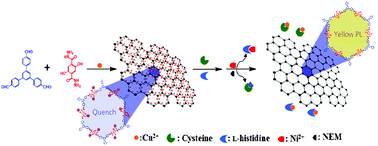A water-soluble copper-immobilized covalent organic framework functioning as an “OFF–ON” fluorescent sensor for amino acids†
Abstract
In this paper, we describe the construction of a new fluorescent hydroxyl- and hydrazone-based covalent organic framework (TFPB–DHTH COF) through the one-pot polycondensation of 1,3,5-tris(4-formylphenyl)benzene (TFPB) and 2,5-dihydroxyterephthalohydrazide (DHTH) under solvothermal conditions. The synthesized TFPB–DHTH COF possessed high crystallinity, a regular pore structure, excellent chemical stability, and sites featuring functional groups suitable for interactions with metal ions. In addition, the TFPB–DHTH COF was highly soluble in water and buffer and displayed a strong fluorescence emission under UV irradiation. The fluorescence of the TFPB–DHTH COF was quenched selectively by Cu2+ ions, forming a non-fluorescent copper-immobilized TFPB–DHTH COF (Cu@TFPB–DHTH COF); the off fluorescent state of the Cu@TFPB–DHTH COF was efficiently and selectively switched on upon the addition of cysteine (Cys) and L-histidine (L-His). Therefore, the Cu@TFPB–DHTH COF functioned as an “OFF–ON” fluorescent sensor for the detection of Cys and L-His. When incorporating N-ethylmaleimide and Ni2+ ions, we could separately and selectively detect Cys and L-His, respectively. Our new sensing assay could be completed within 30 min; it provided linear relationships with respect to concentrations of Cys and L-His of 2–100 and 2–200 μM, respectively, with limits of detection of 340 and 520 nM, respectively. Our strategy highlights the possibility of using water-soluble COFs as novel fluorescent sensors for amino acids, with promise for applications industrially or in environmental remediation.

- This article is part of the themed collection: Popular Advances


 Please wait while we load your content...
Please wait while we load your content...